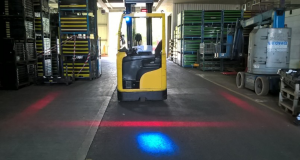If you plan to purchase forklift blue lights, you need all the help you could get to help you make the right decision. This article will provide an in-depth look into the most critical aspects of the buying process to point you in the right direction.
Forklift lights play a crucial role in illuminating the area and warning people about an approaching or turning forklift. If there were no lights on the forklift, then people would get hurt – and there would be endless lawsuits at the workplace. Forklift lights come in all shapes and sizes to fit the varying uses or operations. If you are planning to buy some lights soon, then consider this quick guide to buying the right forklift lights.
Table of Contents
Find the right vendor
A quick search for forklift lights vendors online will reveal dozens of results. But like with other businesses, these vendors are not the same. Some offer quality lights from reputable firms, while others don’t. There are only in it for quick money. So, before you purchase forklift blue lights or any other type of light you are interested in, you need to make sure that the vendor has a good reputation. Ask for references, read online reviews and testimonials, and do your due diligence upfront. You’re likely to get a good-quality light buying from a reputable vendor than one that’s not.
Types of forklift lights
There are different types of forklift lights. The most common ones are the headlights and tail lights. Headlights are placed at the forklift front while the taillights are on the forklift’s back or rear. In addition to these two standard forklift lights, there are also the red side pedestrian light, blue pedestrian spotlights, and strobe lights. When configured on a forklift, these lights are placed at the front, back, and side and enhance safety in forklift operation.
The OSHA requires forklift operators to have forklift headlights when operating at night, outdoors, or in low lighting spaces. Headlights illuminate low-light areas and help forklift operators and pedestrians see the truck in well-light areas. On the other hand, forklift tail lights are useful in areas with lots of foot and vehicle activity. They help inform those behind the truck about abrupt stops or slow speeds. Taillights aren’t a requirement for OSHA.
Similarly, OSHA doesn’t require operators to have red sidelights, blue spotlights, and strobe lights. However, adding these lights can add an extra layer of cushion to your workplace safety. Like the other lights, these lights serve as a warning or approach light. Blue lights enhance safety in environments where many blind intersections. Strobe lights light up the area when the truck moves and acts as an additional visual indicator that the truck is moving or changing speeds or directions.
Consider the bulb types
You’ll have a range of bulb options to pick from, each providing different lifespans and strengths. The most common light options are LEDs, halogen lamps, and sealed beams.
LED forklift lights
LED lights are durable. They are high quality and last about 30 times longer than sealed beams. They can also produce over 1,000 lumens of light. The only downside to LED lights is that they are a bit costly than other lighting options. But if you consider the amount of value LED lights offer in areas that need powerful illumination, then the cost is worth it. Besides, since they are long-lasting, you get to save money on lower electric bills for battery-powered products as well as replacement costs.
Halogen lights
You probably know these lights because they are a standard for car headlights. Halogen lights project stringer light beam when matched to sealed beam forklift lights. There are easy to install – you just fit them into a connector. But since these lights use a typical bulb with filament, they are easily damaged with shock or vibration. They also draw more amps and will drain your battery faster than LED.
Sealed beam forklift lamps
These are the most basic lighting option and are often used in headlamps and other front-facing lights. They are affordable and straightforward, yet pretty fragile. Sealed beam lights also have a lower lifespan than the halogen and LED counterparts.
Consider the light’s specifications
You can’t just buy your lights as a commodity. You need to test and put them through paces to make sure they are a perfect fit for your specific site. For instance, when buying forklift blue lights, it’s best to pay close attention to the wattage, UL ratings, and lifetime replacement warranty. If you have an average facility with decent lighting, for instance, you may get a blue light with wattage of 1000 lumens or more.
This is just a quick guide to buying the right forklift lights. Your vendor should be able to answer any further questions you might have regarding the forklift lights.
